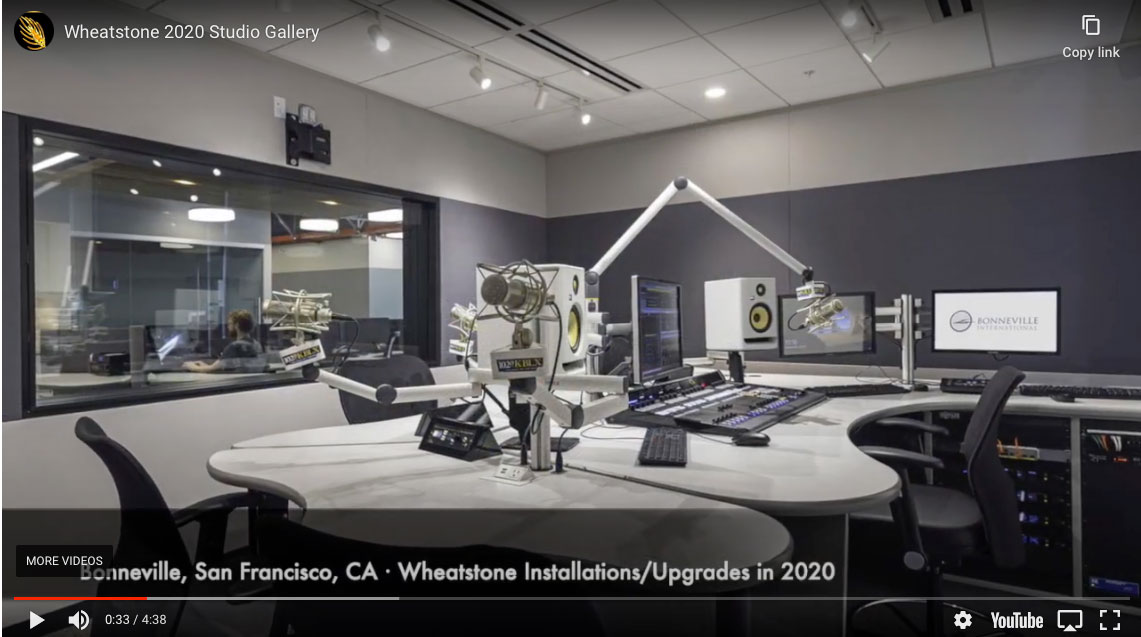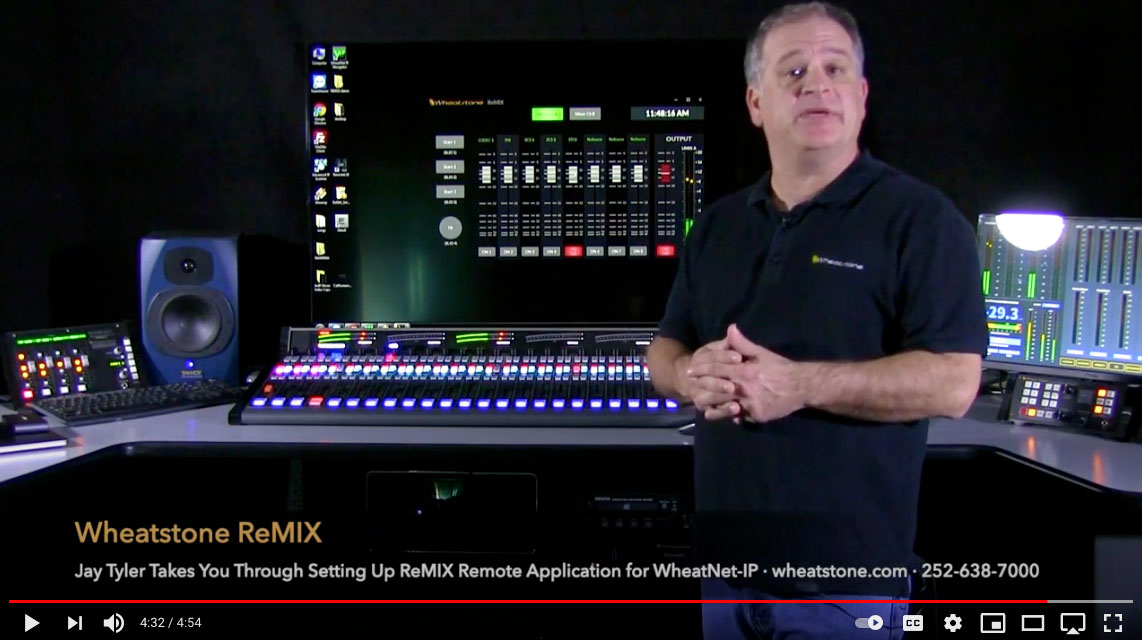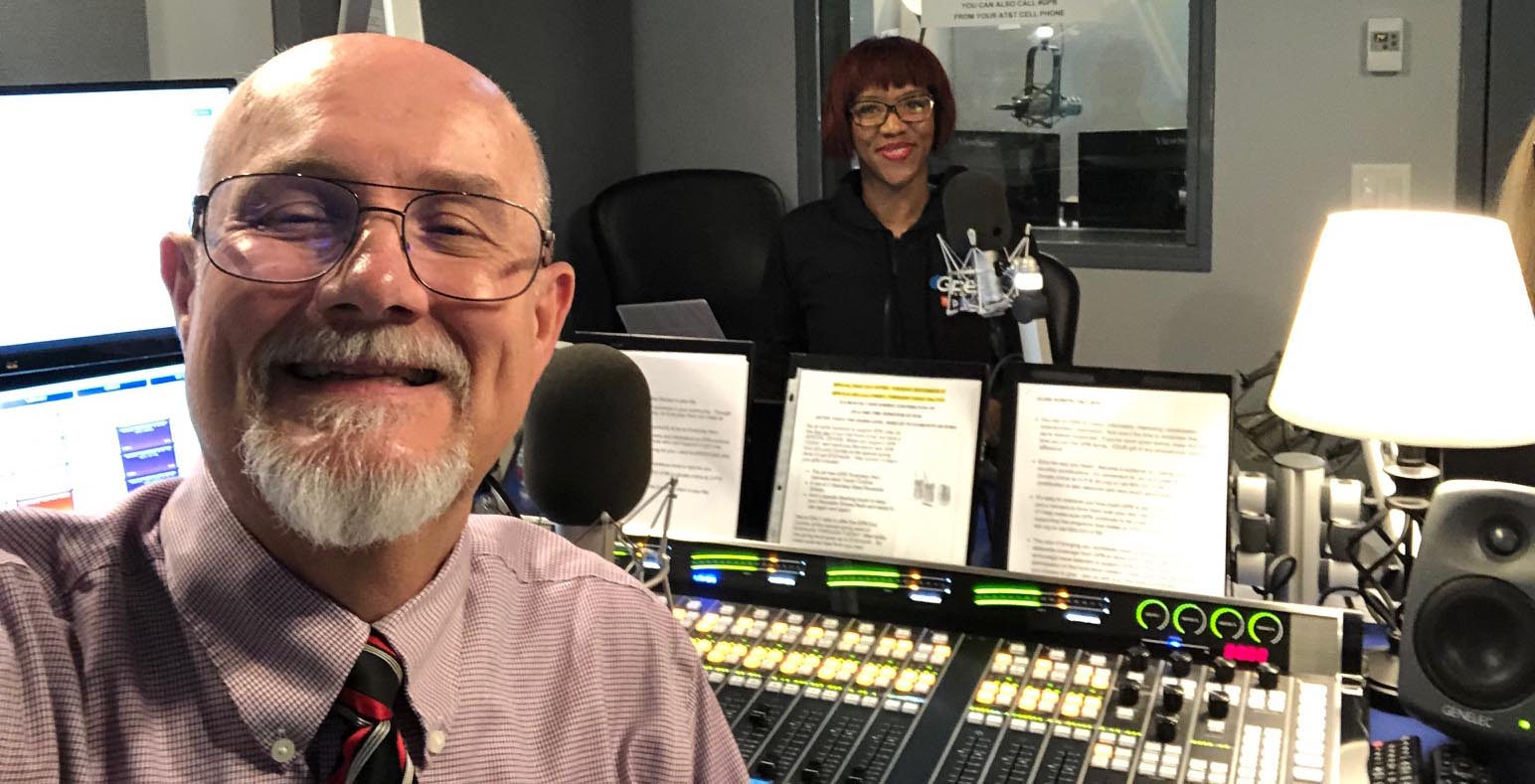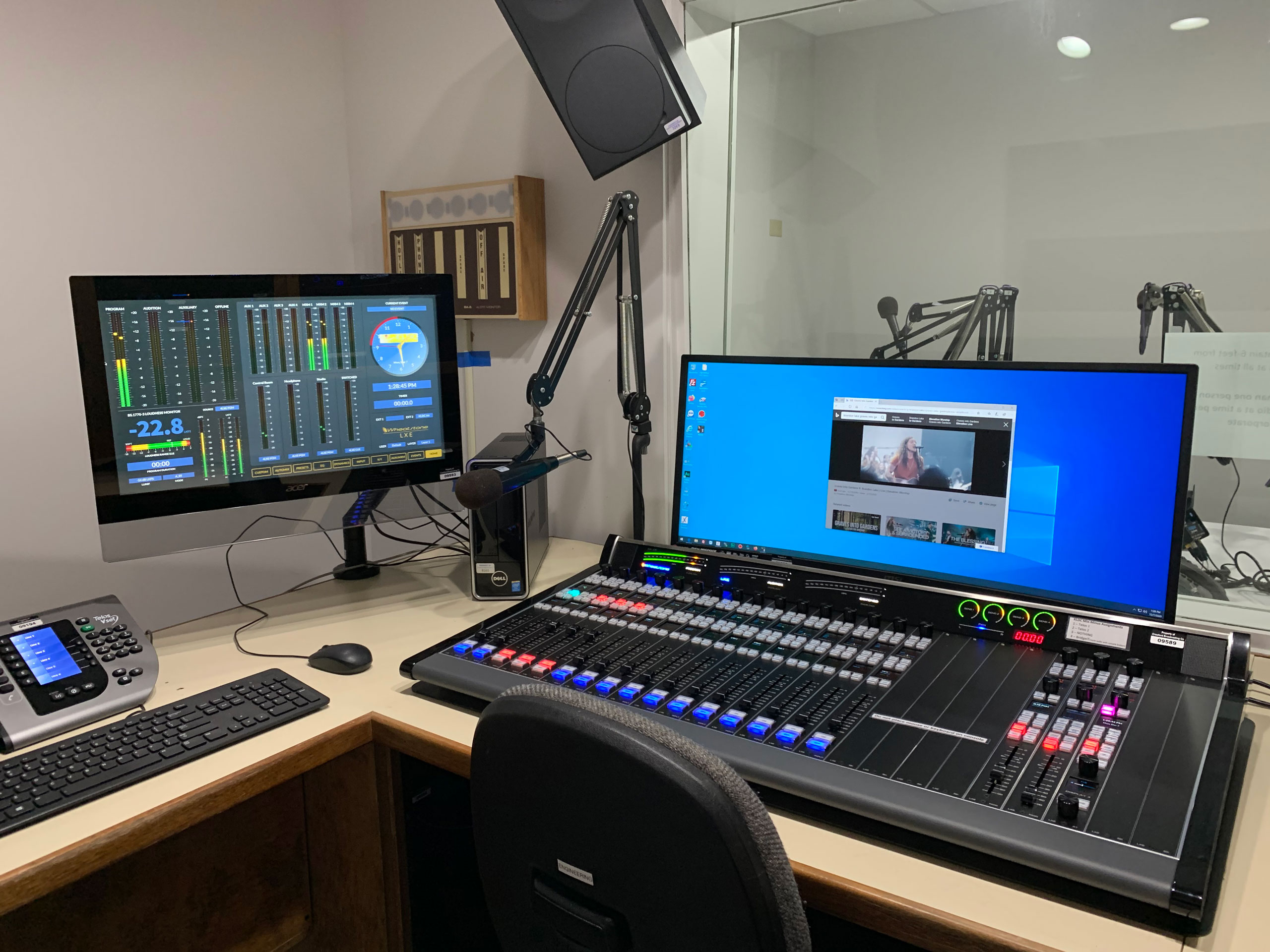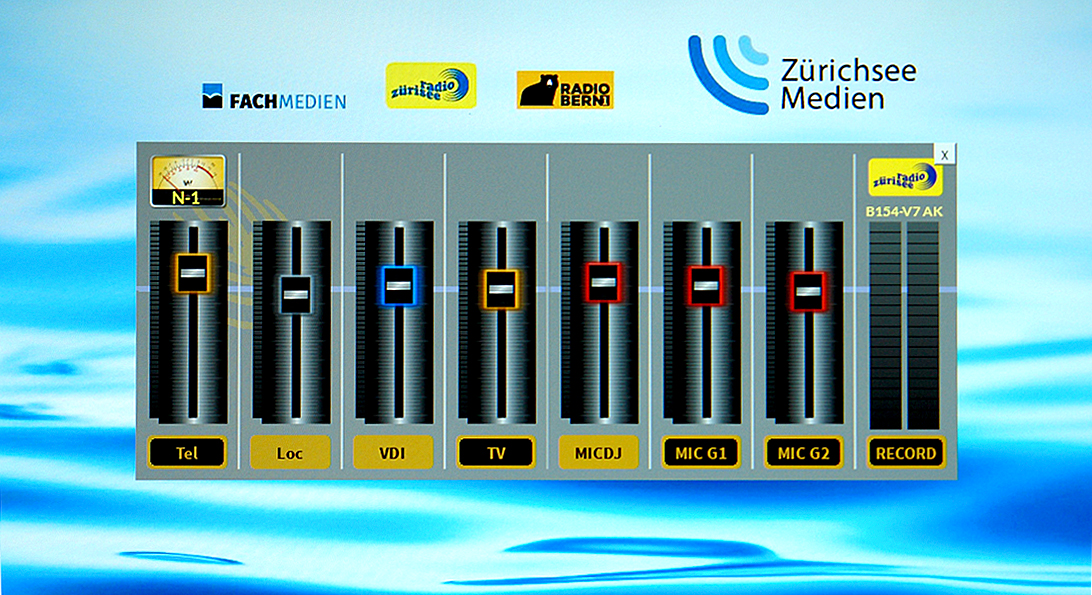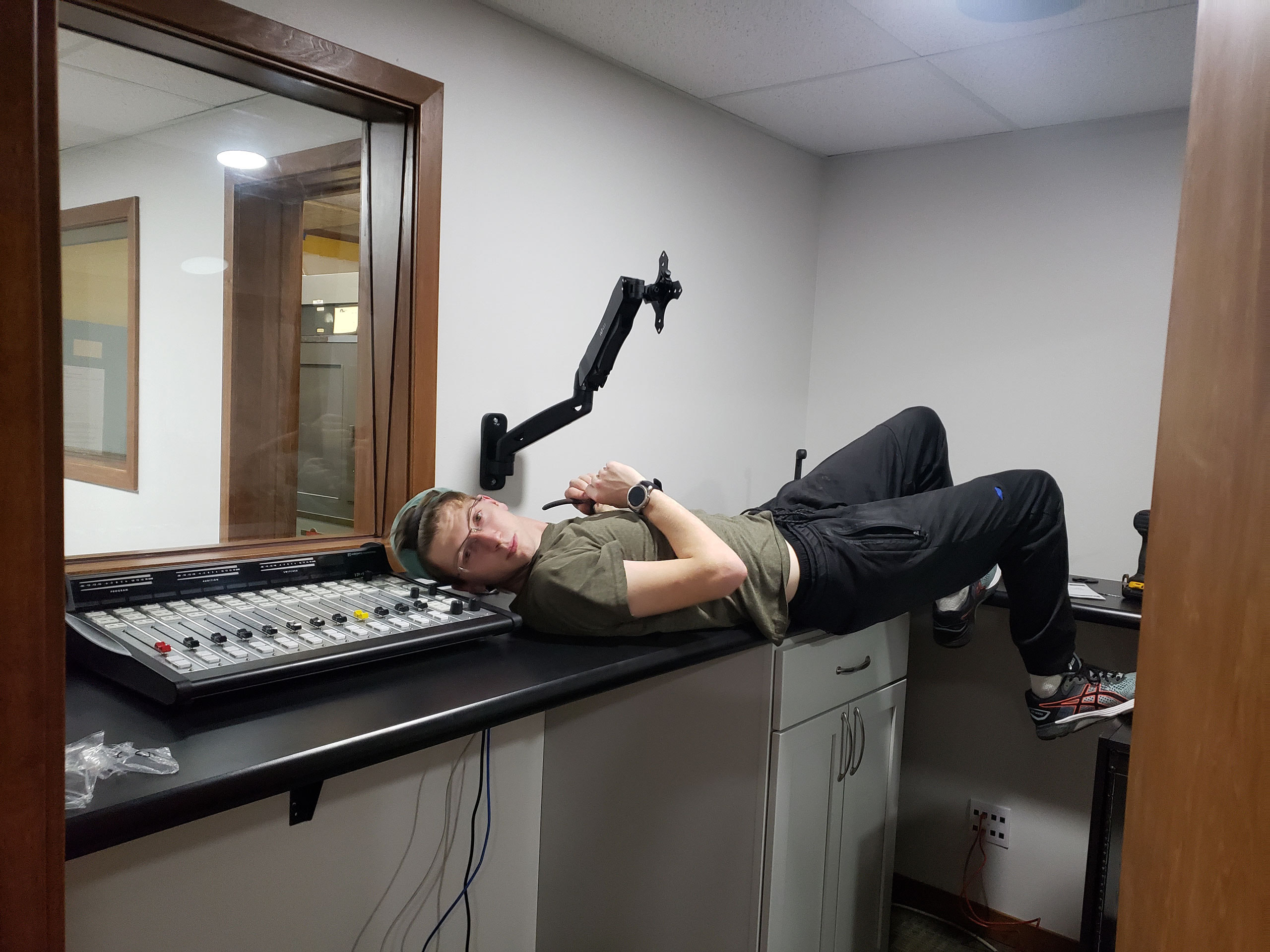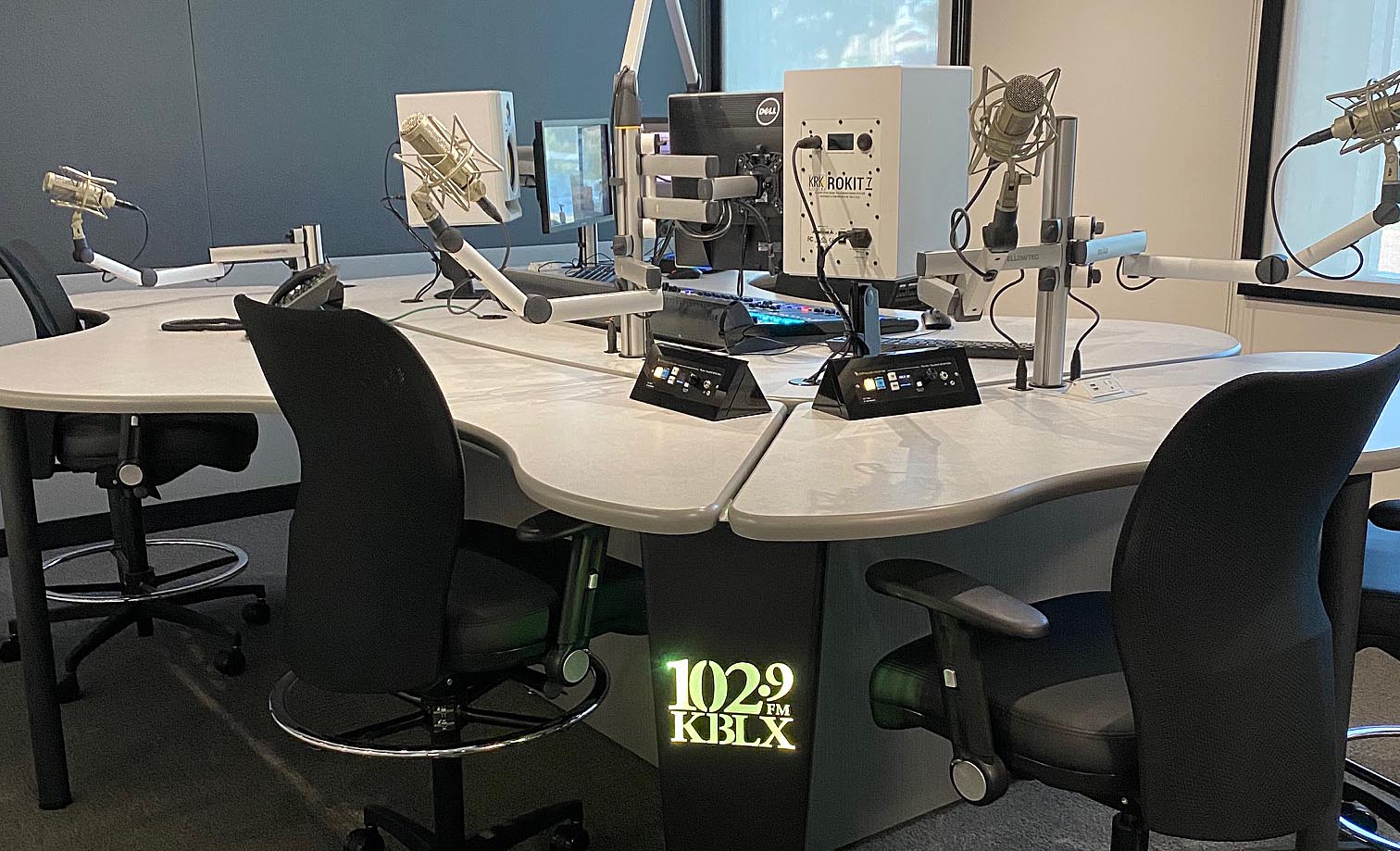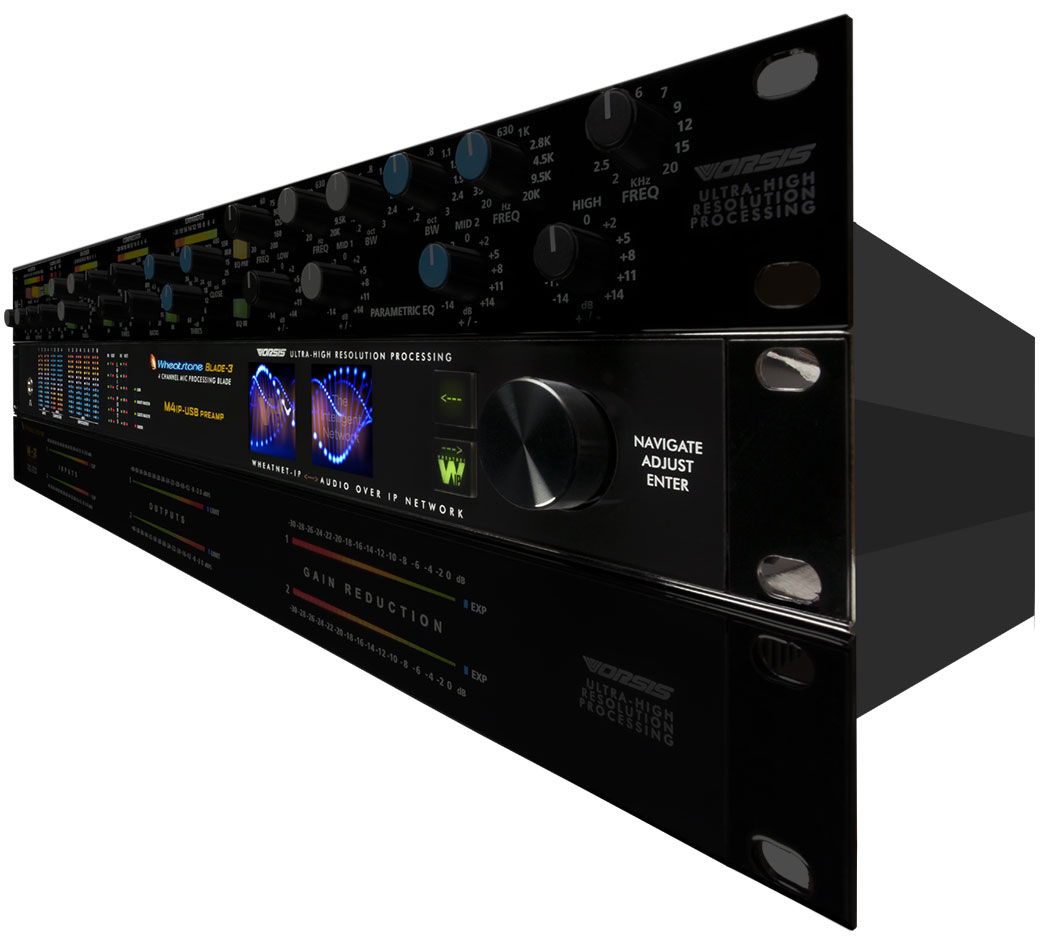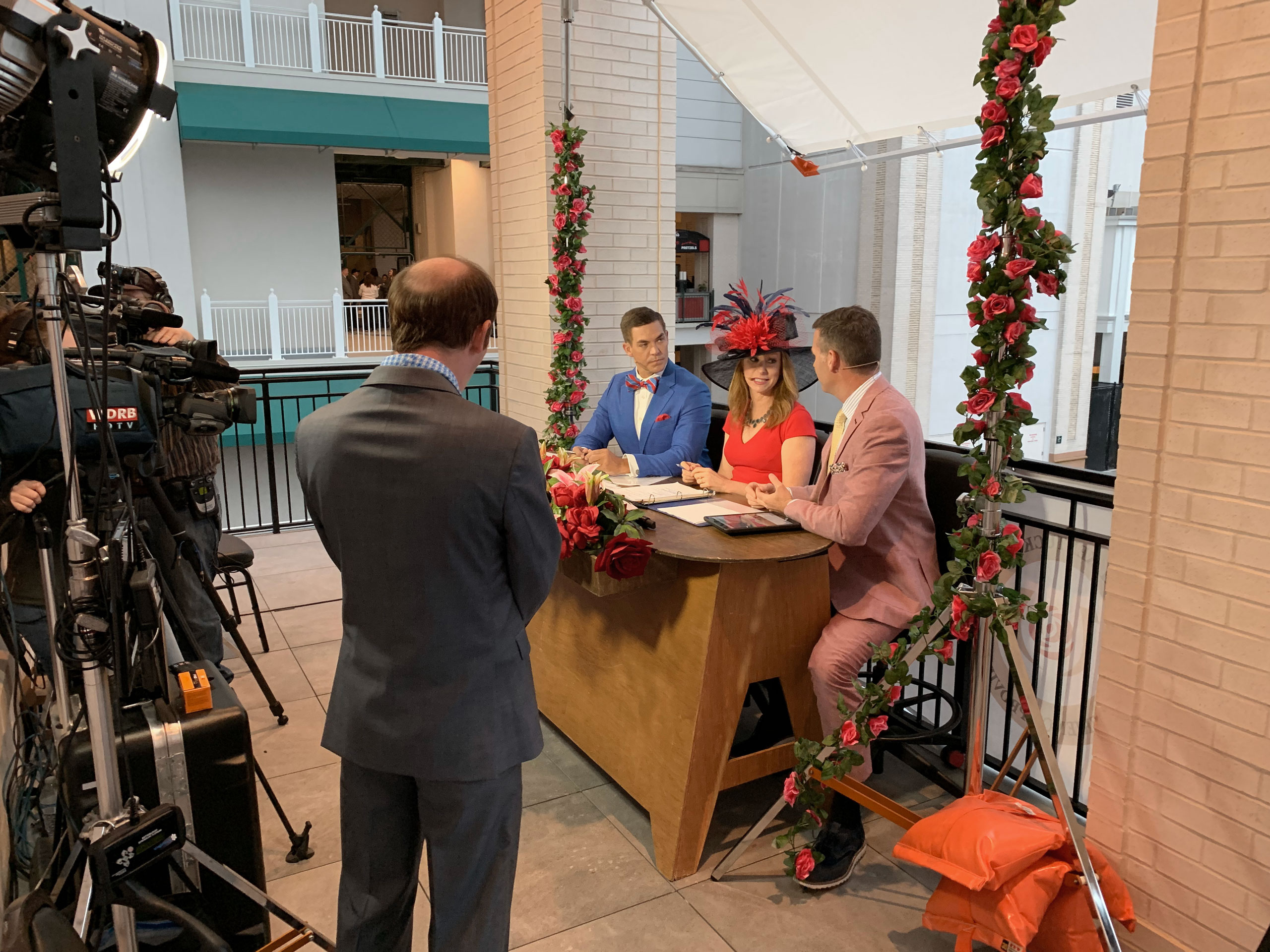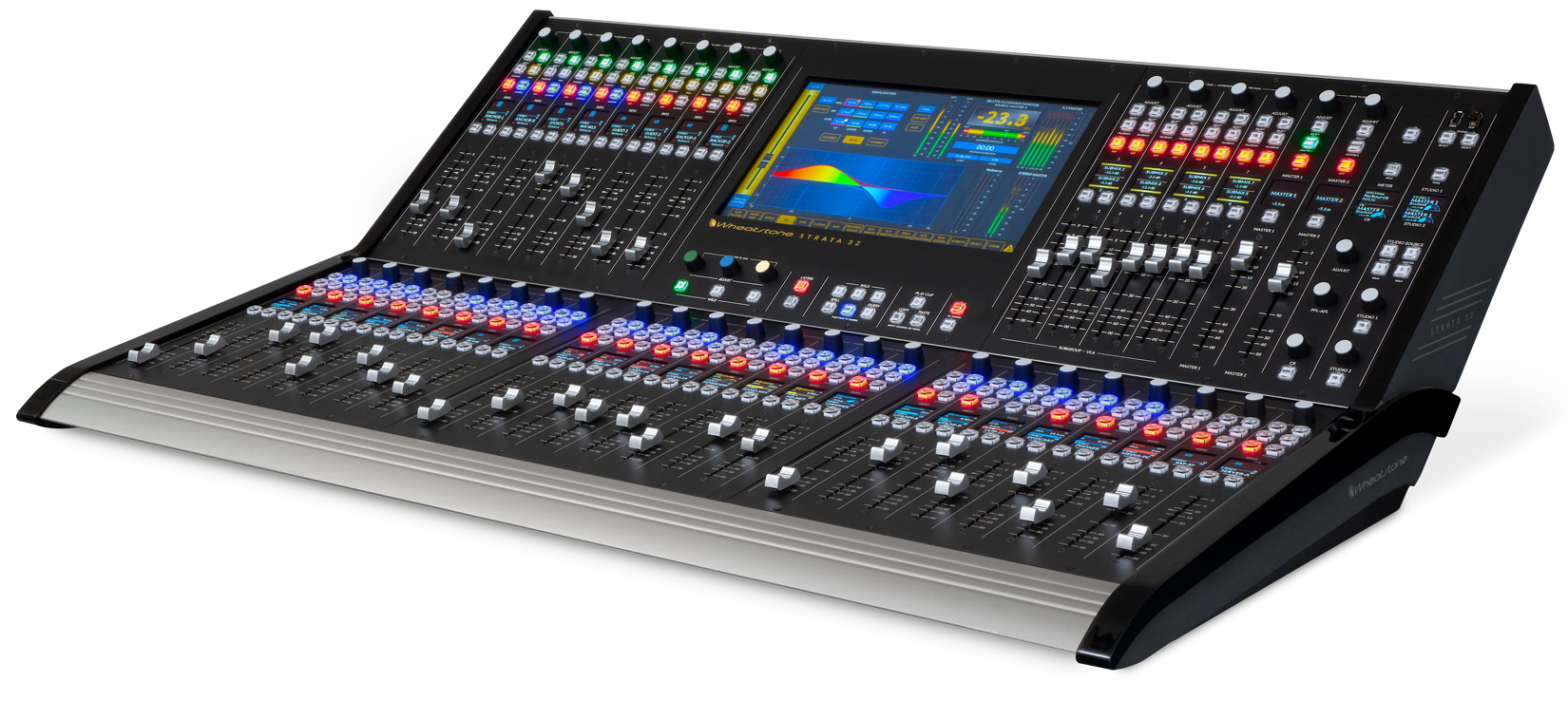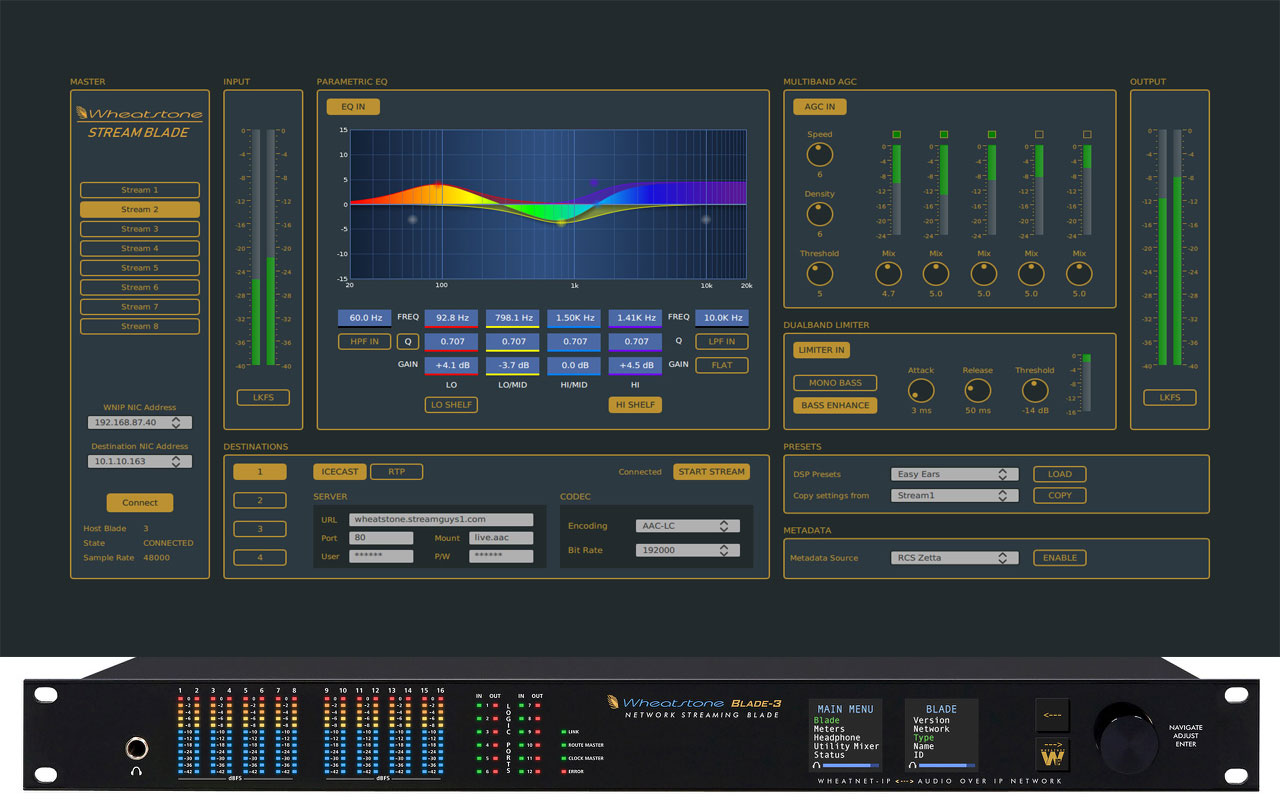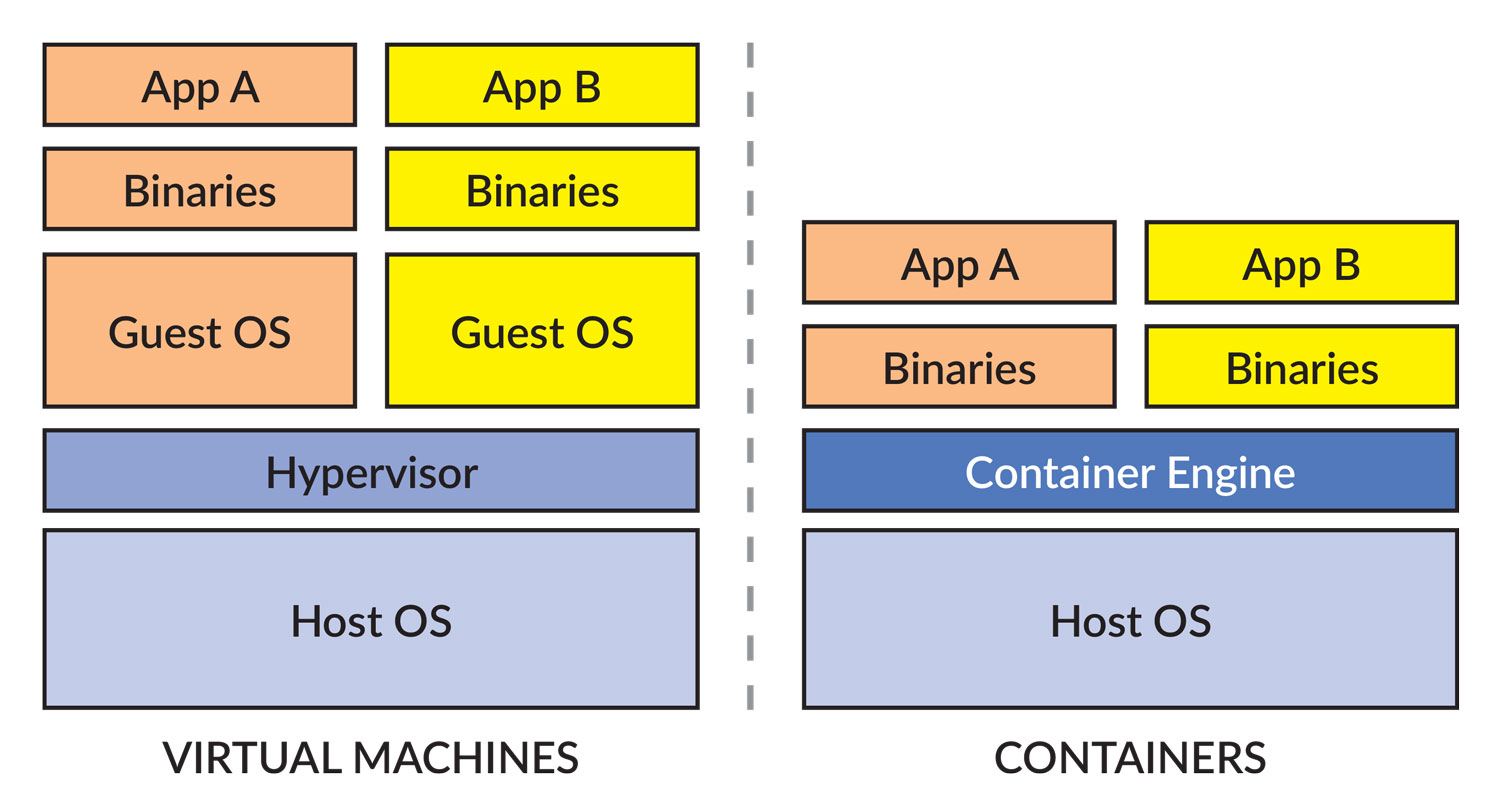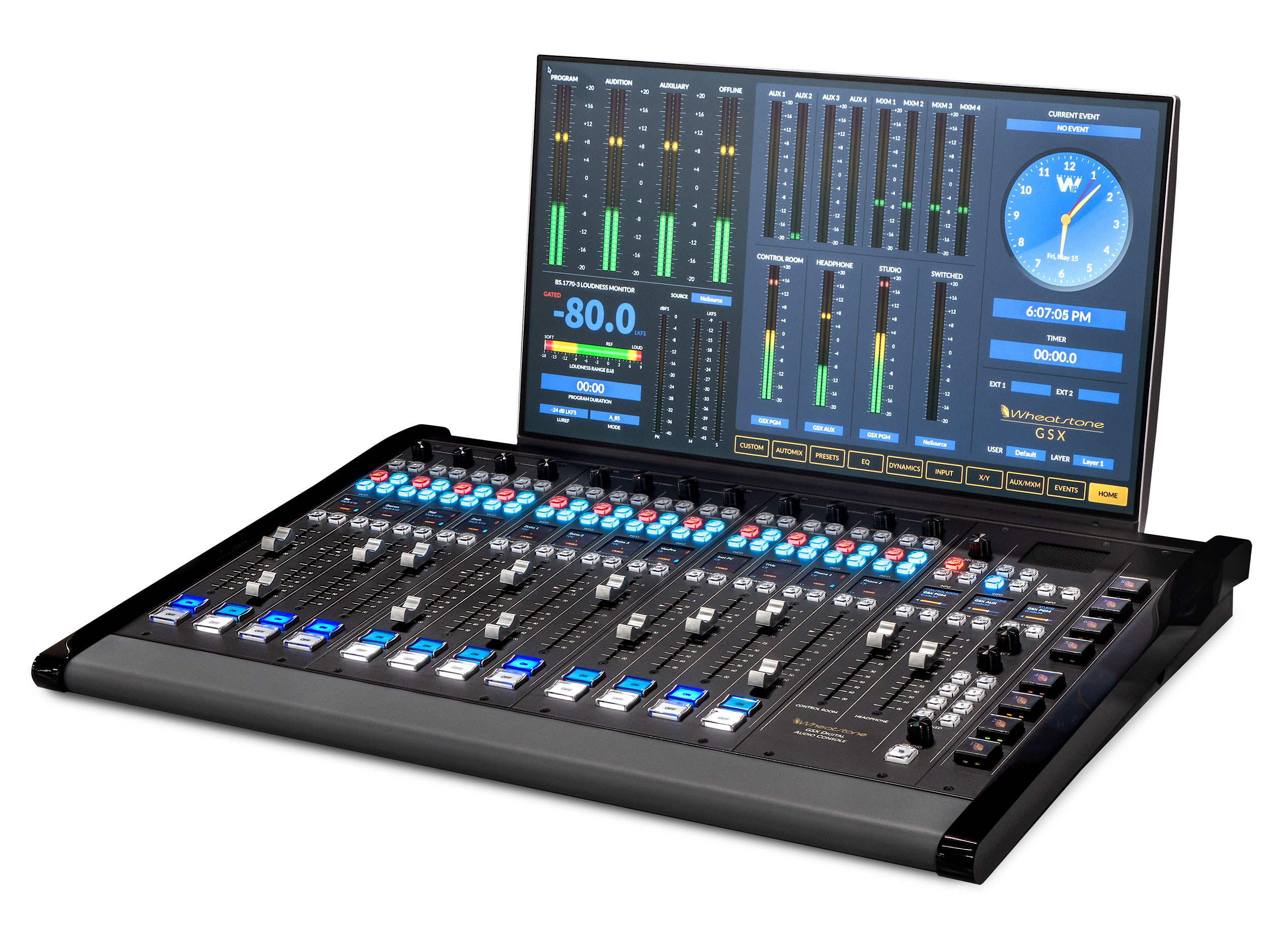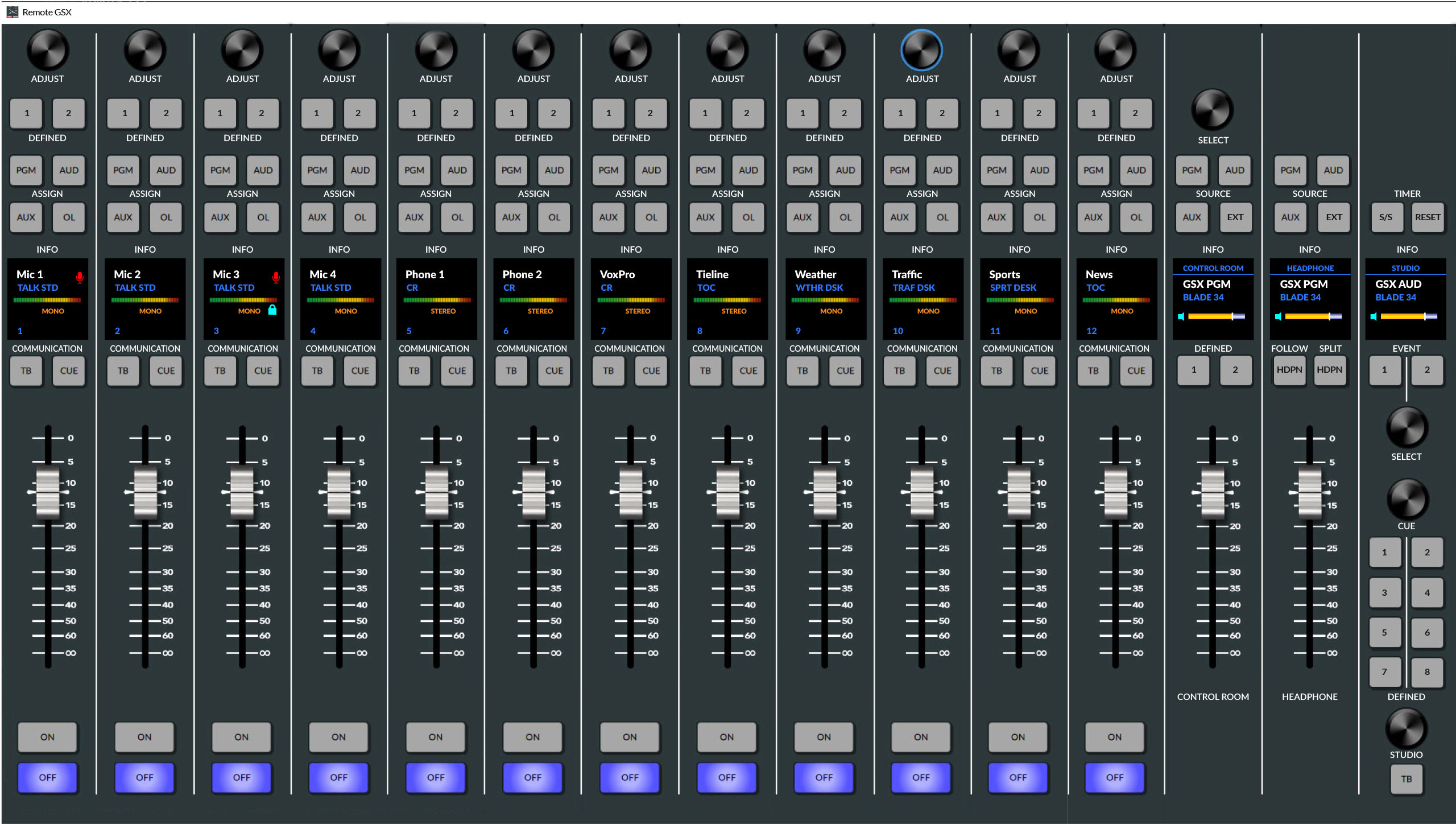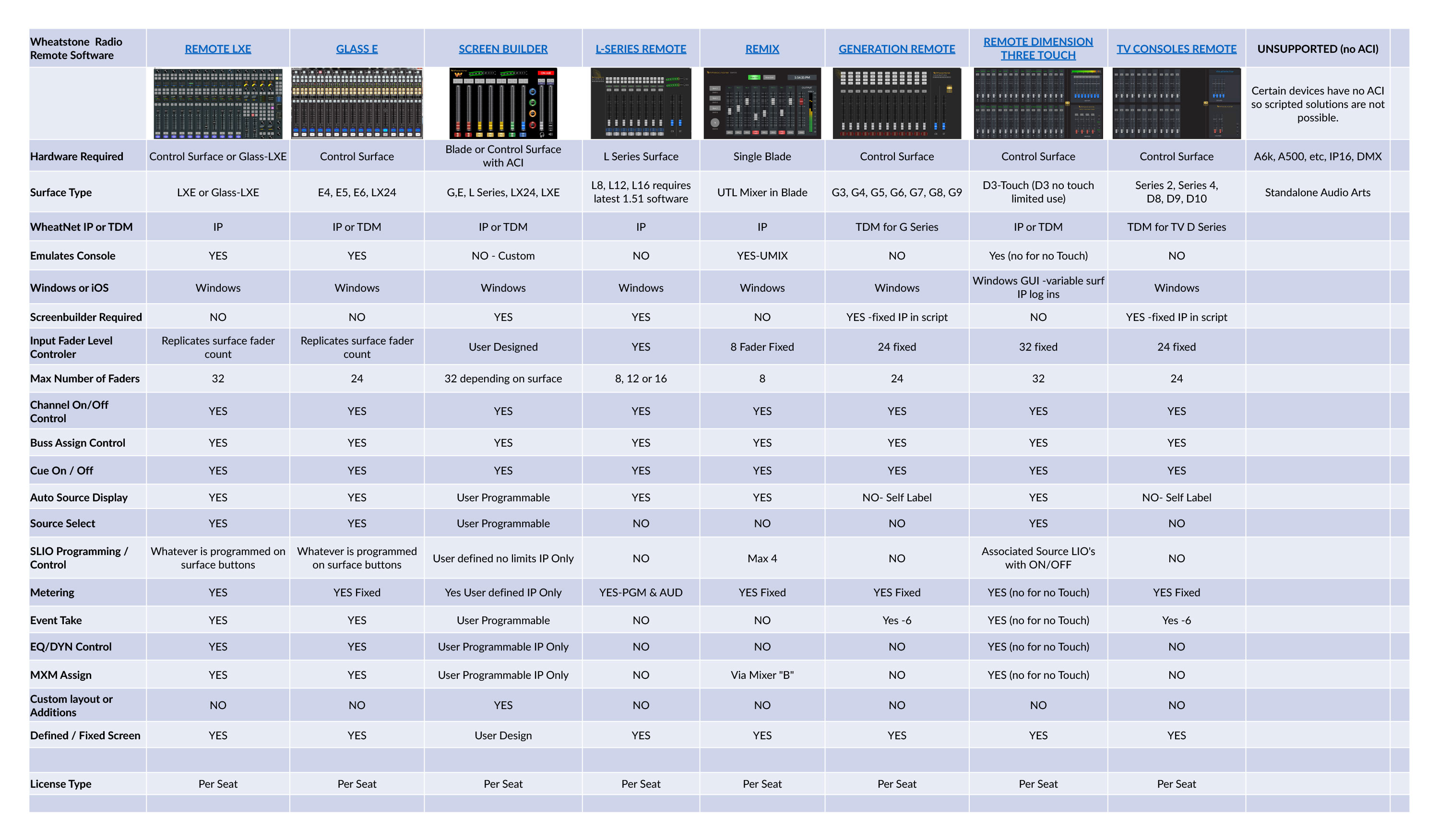WHEAT:NEWS JANUARY 2021 Volume 12, Number 1
Your 2021 Reset Button
Here is the 2021 reset button you’ve been waiting for all these months. But before you dump one giant *&@ [expletive] of a year, we’d like to remind you of a few good things that came out of 2020.
Like, the 28 studio projects captured in the video to the right, every one of which was completed during a global pandemic.
There were also strides in streaming, a renewed focus on local broadcasting, and virtual/remote triumphs during 2020. We’ll certainly bring all that into 2021 with us, along with our new AoIP Blades, surfaces, remote applications, Audioarts accessories, and recent developments in processing and cloud technologies.
And we’ll keep our Emmy that we got in 2020, thank you very much. Read on.
Killing It Forward
2020 was going to be our year. We were killing it. We had been slaving away on radically cool AoIP tech for the NAB show and we were practicing our acceptance speech for an Emmy award, which we were supposed to receive at a gala event during the show.
We all know what happened next. Everything ground to a halt, broadcasters retreated home, and the annual NAB show was struck from the calendar along with the IBC show and so many others we regularly attend. 2020 was a bust in many ways, but we still have radically innovative new Blades to show for it along with a streaming appliance that rocks, a surface that’s putting a new face on consoles, and some useful anywhere, anytime AoIP tools.
Oh, and we finally received that Emmy award for our AoIP work, which is now prominently displayed on our president's desk at the Wheat factory.
This Emmy showed up at our door earlier this month with our name on it and we’ve been pinching ourselves ever since.
The Television Academy gave us this Emmy Award for our contribution to the “development of synchronized multichannel uncompressed audio transport over IP networks!”
Wheatstone’s earliest AoIP device was a plug-in card for our TDM network. That was the first blush of what was to come − using Ethernet instead of soundcards. Now, of course, AoIP is the backbone of just about every modern broadcast plant today.
Because of the AES task force, we now have an important AoIP standard: AES67.
Congratulations to all our developers at Wheatstone, to the Audio Engineering Society, and to our industry friends for this shared recognition of our work and others' work on AoIP.
Our Vice President Andrew Calvanese will be accepting this prestigious award on behalf of Wheatstone during the 71st Technology & Engineering Emmy Awards Ceremony taking place on Wednesday, Oct 21st at 4 p.m. as part of the NAB NY Show.
The folks at KING-FM, Seattle, had just finished installing this magnificent new studio and had made it through their grand opening ceremony when Covid-19 hit.
By the time anyone had given any serious thought to the LXE console shown here, it was a Sunday night in March and no one was around except one board op who was there to cover, live, the evening choir at Saint Mark’s Episcopal Cathedral in downtown Seattle.
What better way to bring a sense of normalcy to listeners during this time of uncertainty than the liturgical music and Gregorian chants of The Cathedral Choir, right?
But at a few minutes before live air, something went wrong.
“I get a phone call from the board op literally 4 minutes before they were supposed to go on live who said she had a problem,” said Erik Utter, the integrator on the studio project, who immediately opened up his laptop and loaded up the Remote LXE software that let him take control of the control room LXE console. “I was able to remote in to the system, fix the issue with the codec, and while I was at it, punch up the right source, bring the fader up, and trim the level, all just in time to go on like nothing had happened.”
Whew.
But Wait, There’s More…
In the early days of COVID-19, we had sent most of our staff home to work, with the exception of a skeleton crew in our manufacturing plant and a few research engineers who emerged from our lab a short while later with a new remote app. We released ReMIX into the broadcast community the same month as a low-cost remote mixing app that any broadcaster with a WheatNet-IP Blade could use to remote into the studio from home.
Doin’ the Local-Motion
Before 2020, most of us couldn’t name five U.S. governors if our lives depended on it. By June, we not only knew key governors by name, but also that of police chiefs in certain cities and whether or not local citizens were under curfew or still quarantined, or both.
As the pandemic deepened and civil unrest reared its ugly head, public interest turned to local events and broadcasters like Georgia Public Broadcasting were in the know.
Three months ago, many of us couldn’t name five U.S. governors if our lives depended on it. Today, we not only know key governors by name, but also that of police chiefs in certain cities and whether or not local citizens are under curfew or still quarantined, or both.
If that’s not a referendum on local broadcasting, I don’t know what is.
It’s just one more crazy twist in recent events that are keeping broadcasters like Georgia Public Broadcasting (GPB) hopping. GPB covers local politics across 18 radio stations and nine television stations in the state of Georgia. Remote production has become more frequent and more “interesting,” even by election year standards, according to GPB Radio Operations Manager Tom Barclay.
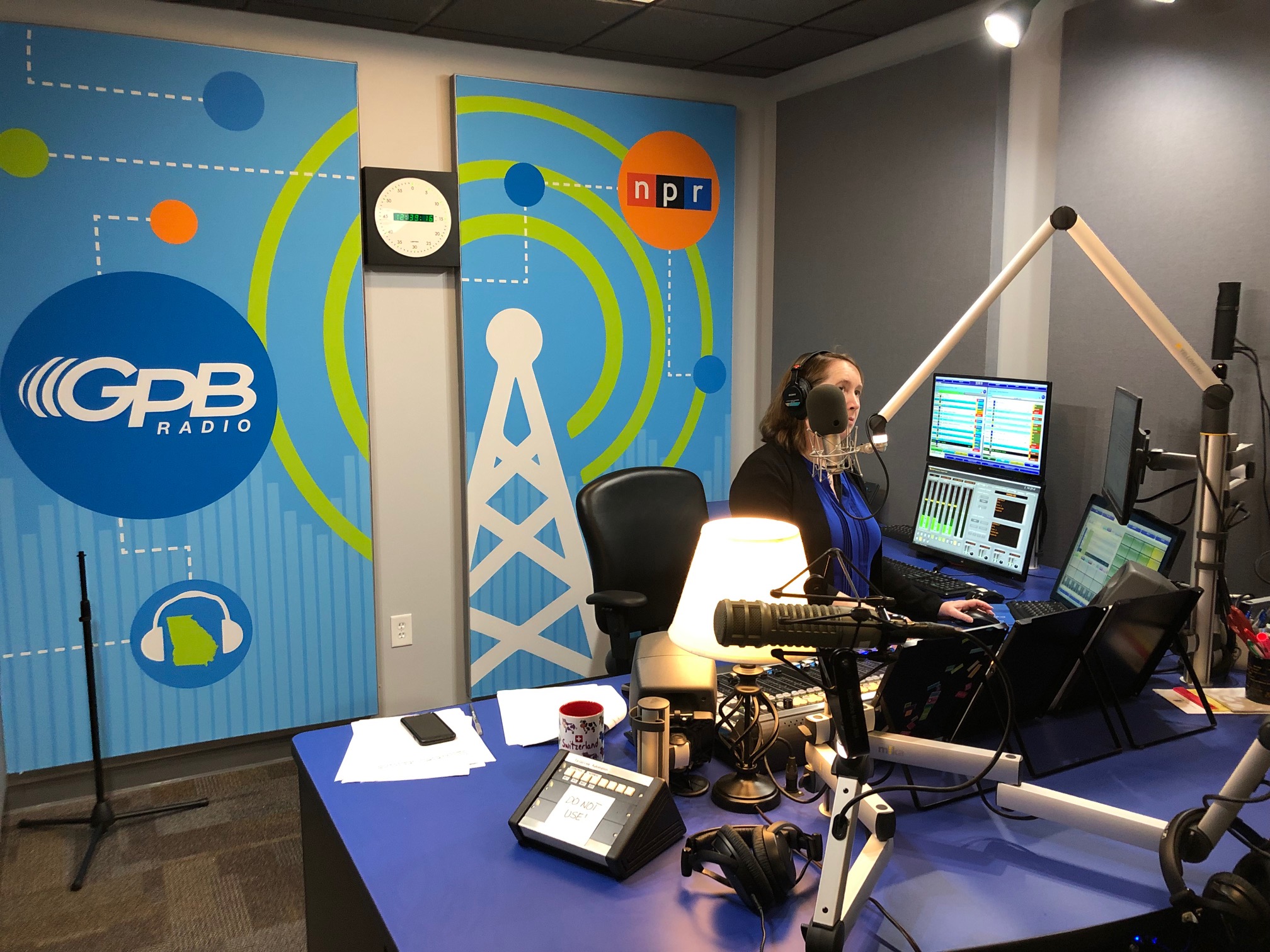 At the time I talked to Barclay in mid-March, he was preparing for yet another live address by Georgia Governor Brian Kemp, the latest in a long litany of breaking news events.
At the time I talked to Barclay in mid-March, he was preparing for yet another live address by Georgia Governor Brian Kemp, the latest in a long litany of breaking news events.
“For this one, the Governor’s going to be on one TV screen, the Commissioner from the Department of Public Health will be on another TV screen with a reporter, and four or five guests will be in different studios,” he explained.
The broadcast went out on all GPB stations along with national and local affiliates, both commercial and public − feeds originating from studios that are sparsely staffed, courtesy, once again, of Covid-19.
In the weeks leading up to the pandemic, Barclay had spent some time setting up salvos on the studio LX-24 consoles so that operators could interrupt the ENCO automation and mix feeds from any three of the adjoining studios in the facility during a live-breaking situation. The consoles are part of the WheatNet-IP audio system installed in 2018 to network GPB’s radio facility of four edit studios, an on-air studio, a production studio and a talk studio. To repurpose broadcast television audio for radio, GPB uses a Wheatstone HD-SDI BLADE into the WheatNet-IP network that de-embeds audio from the video stream for direct input to the console and then on-air.
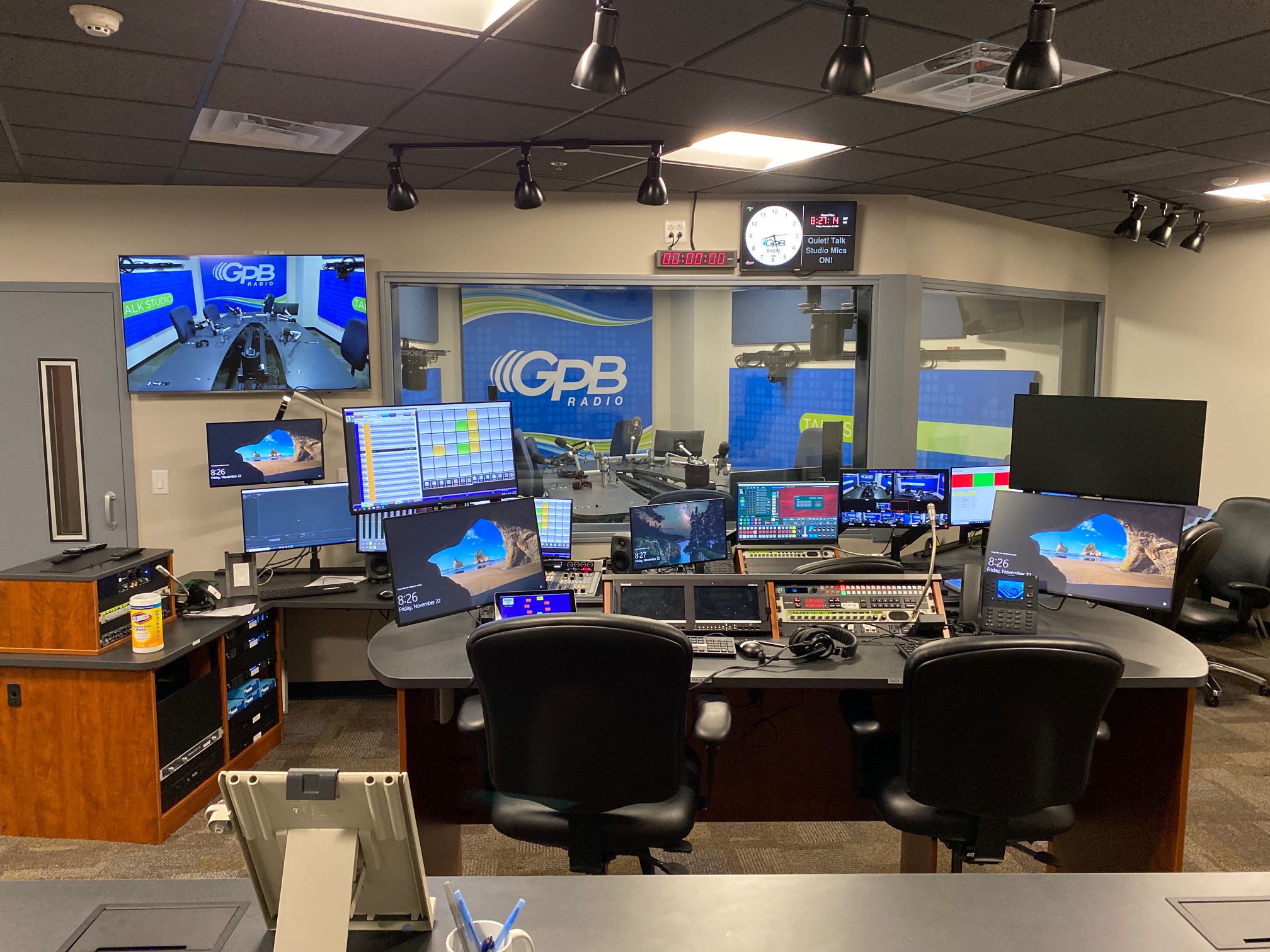 “I really enjoy that part of my job where I get to play around with all these tools,” said Barclay, who just hours before we talked had set up salvos to interrupt the 18-plus station IDs coming from another ENCO system during a breaking event.
“I really enjoy that part of my job where I get to play around with all these tools,” said Barclay, who just hours before we talked had set up salvos to interrupt the 18-plus station IDs coming from another ENCO system during a breaking event.
He has since added Glass E remote client software for the LX-24 boards so that instead of having someone come in to turn the feed on or off and insert whatever breaks are needed, he can do all that remotely from home. (Remote client software mirrors the console so that settings can be changed remotely).
It just doesn’t get much more local than that.
Can someone please explain why anyone would take on a big studio project in the middle of a pandemic?
Crawford Broadcasting DOE Cris Alexander certainly can. Cris and his engineering team just completed a studio renovation and conversion to WheatNet-IP in Chicago and are now in the middle of the same for Crawford stations in Denver, with Birmingham and Detroit to follow.
In his December newsletter The Local Oscillator, he explained that with the exception of Chicago, these were scheduled replacements, although they weren’t scheduled until next year. “We were running into parts availability issues for the old consoles, and even though Wheatstone has been great in finding workarounds, the clock was ticking… really loud,” he wrote.
Another big reason: the remote thing. “Last spring (and maybe again soon), we had to run several of our markets remotely, with no one in the studios at all. This was a piece of cake at KBRT in the Los Angeles market, where we fully converted to WheatNet-IP in 2019… We didn’t miss a beat, even with live programming,” he wrote.
Crawford is now equipped to that level, and beyond, in Chicago and soon will be in Denver, Birmingham and Detroit.
A third and crucial reason for moving these projects forward is Cris’ belief that the future is in IP infrastructure. “Analog and AES are things of the past. I have spent untold hours in planning the architecture of these new systems, and it amazes me how few signals there are in those domains. There are still a few analog signals, mostly having to do with EAS and PPM (monitor sources) and some satellite feeds. We still use AES to get into and out of some of our codecs and EAS encoders, but that’s about it. Most of our sources are WheatNet native, including Nexgen, and that certainly simplifies things – and it really cuts down on the wiring,” he wrote.
Looking ahead, he can see employing AoIP in the transmitter site audio transports (outbound and return). “Codecs have long been a bottleneck (and pain in the neck) in those applications. Some are better than others. How great would it be to be able to route directly to a processor input without going through a codec? And how great would it be to be able to route a mod monitor or satellite receiver output from the transmitter site to any destination back at the studio?
The reality is that we could make that leap even now in many locations, relegating codecs to backup links. For many of our AM stations, however, we’re constrained by the half-duplex 802.11 links between the microwave radios on top of towers to the transmitter building. I’m told, however, that our friends at Wheatstone have a solution for even that, and we plan to test-drive it early next year,” wrote Cris.
His final thoughts on projects of this nature include his engineering staff. “As wonderful as the technology is, it’s still the engineers that make it work.”
We couldn’t agree more.
Cris Alexander puts out an excellent engineering newsletter. You can find the current issue and several back issues of The Local Oscillator here: https://crawfordmediagroup.net/crawford-engineering/).
IP Was Happening in the Heartland, Too
IP. Now Is The Time
Upgrading or replacing your automation hardware? Now is the time to go IP. IP means no more expensive soundcards, special cables, breakout boxes or external switchers, so it actually pays for itself.
Moreover, AoIP will streamline your installation and increase workflow by taking advantage of resource sharing, routing, and anything anywhere, all synchronized on a common network.
IP. Now Is The Time. Consider an entry-level AoIP system like our DMX console with Audioarts mix engine, which uses IP audio drivers instead of soundcards and has a built-in 5-port switch for networking together a smaller local network. With this, you’ll be able to integrate AoIP routing and control with your automation system through our ACI protocol, so you have data, control and programming all synchronized together on a single cable.
Cooking the ‘Ronas
Meanwhile, back at the factory, we started wheeling in incoming parts, supplies, mail, and materials − anything that would fit in our production oven went in. We loaded it all up on a special cart in a quarantined area of the building, and Marty wheeled it into the oven. A few minutes at 200° F / 93.3° C took care of any ‘ronas...
Radio Zürisee, Switzerland, installed one of the first virtualized systems for broadcast. It involved virtualizing 24 workstations into one VM with “floating” WheatNet-IP AoIP drivers and virtual mixing console app.
Shown is the seven-channel virtual mixer designed by Radio Zürisee Senior Chief Engineer Mario Göldi using ScreenBuilder for use by talent in their offices and reporters in the newsroom. Note the VDI channel indicating signaling from the VM located in the TOC, which contains the 24 workstations housed together into one Virtual Desktop Infrastructure (VDI). Users can open a virtual Windows® environment from thin client computers by initiating a session with the VDI server. During a session, client workstations can request a “floating” WheatNet-IP audio driver and mixing app for use during that session and after logging out, the driver and mixer are reallocated back to the server and available again upon request.
Radio Zürisee was one of the original beta users for the floating AoIP drivers and applications developed by Wheatstone engineers for virtualized system environments.
A Look Into The Future
We got to know 19-year-old Sean McGee early on in the pandemic and were blown away in the ensuing months as he designed, managed and implemented an entire WheatNet-IP studio rebuild for Raccoon Valley Radio in rural Iowa. Sean, along with so many of the broadcasters we worked with over the course of the year, proved to us that even though 2020 threw us all a few curveballs, there was a still a lot about the year worth carrying forward into 2021.
You probably have a few consoles that are older than this guy.
Sean McGee is 19 years old and he just completed a WheatNet-IP studio project for Raccoon Valley Radio headquartered in Perry, Iowa.
He came up with most of the network topology, put together the materials list, and moved studio operations into a temporary garden shed (called, appropriately, Radio Shack). He then gutted the old studios, set in new IT infrastructure, and finished out a WideOrbit and WheatNet-IP networked main studio, newsroom, two prod rooms, a voicetrack studio and a general-purpose audio conference center for three stations.
This isn’t his first WheatNet-IP studio project. At age 14, Sean helped his dad, Raccoon Valley Radio GM John McGee, switch over to an IP-12 console.
He definitely knows his way around radio and AoIP.
Sean did the salvos, the crosspoint connections and the signal flow throughout the facility using AoIP routing and control logistics. He also created a wall of meters for signal monitoring all the way to the transmitter sites and is working on a virtual mixer for one smaller studio using ScreenBuilder tools and apps, something you’d expect from one of our experienced power users instead of a 19-year-old.
Sean grew up around radio. While other kids his age were putting together Legos®, he was hanging out at his dad’s stations building gadgets, laying tracks or working a board. By high school, he was known as DJ Sean.
Sean McGee bypassed college and plans to become a broadcast engineer. With this project, he’s easily passed the engineering test in our opinion. He can be reached at [email protected].
The I Survived 2020 T-Shirt Goes To…
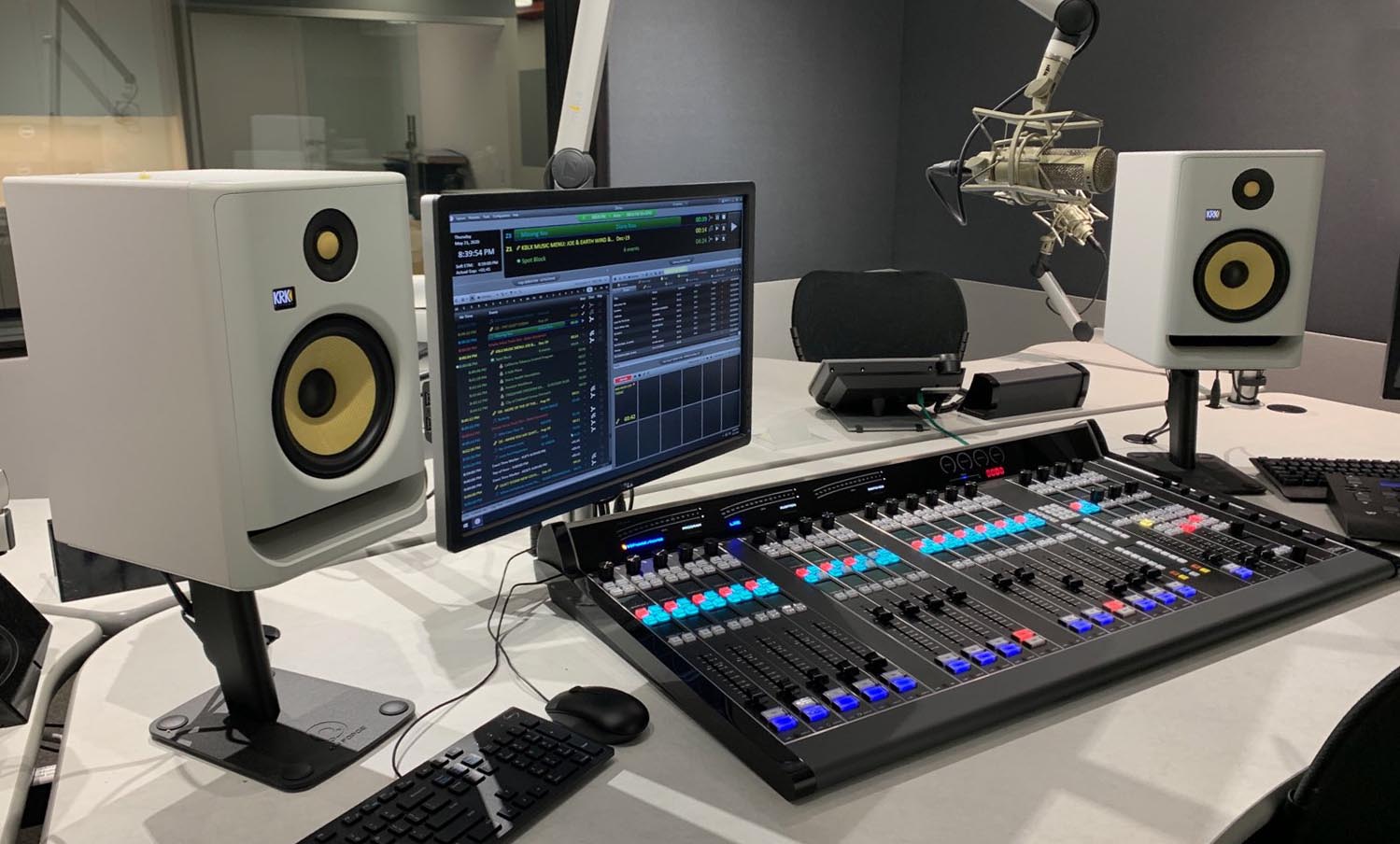 We were working with broadcasters on dozens of new facility buildouts before the switch flipped overnight to at-home studios and everything we knew about the world changed. Among those new buildouts was Bonneville San Francisco, whose team of engineers earned a special I Survived 2020 t-shirt after having to put up walls that they had just torn down along with a million other changes that hit mid-project because of the pandemic.
We were working with broadcasters on dozens of new facility buildouts before the switch flipped overnight to at-home studios and everything we knew about the world changed. Among those new buildouts was Bonneville San Francisco, whose team of engineers earned a special I Survived 2020 t-shirt after having to put up walls that they had just torn down along with a million other changes that hit mid-project because of the pandemic.
You get a special I Survived 2020 t-shirt if you are currently in the middle of a new studio project.
We are working on dozens of new facility buildouts started before the switch flipped overnight to at-home studios and everything we knew about the world changed.
One of those projects is Bonneville’s new San Francisco facility, shown in the photos. “What they did in a short amount of time is amazing. We’re talking full (RCS) Zetta and full WheatNet-IP in the middle of a coronavirus with all kinds of challenges, starting with our gear getting stuck in quarantine,” commented Jay Tyler.
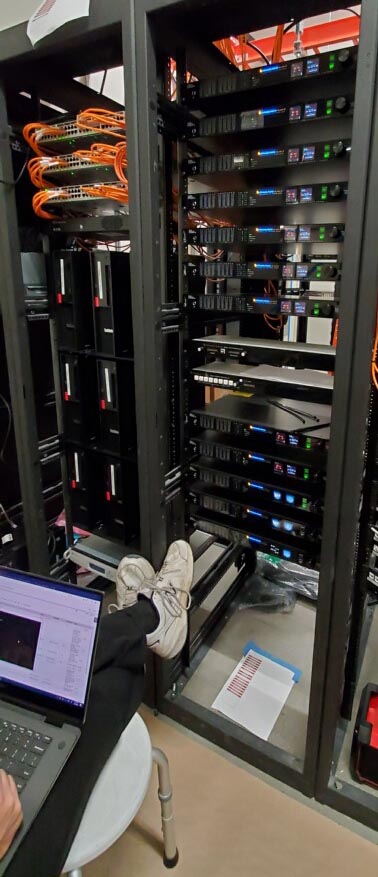 The project is now nearing completion and engineers there have already made several adjustments mid-project due to recent events. They’ve set up privacy panels and rearranged workspaces so operators are not directly facing each other, for example. “Everyone has been working so hard tearing walls down and creating an open concept, and now a pandemic like this, the walls have to go back up,” commented Bonneville Sacramento DOE Jason Ornellas during a recent interview with Radio World’s Paul McLane.
The project is now nearing completion and engineers there have already made several adjustments mid-project due to recent events. They’ve set up privacy panels and rearranged workspaces so operators are not directly facing each other, for example. “Everyone has been working so hard tearing walls down and creating an open concept, and now a pandemic like this, the walls have to go back up,” commented Bonneville Sacramento DOE Jason Ornellas during a recent interview with Radio World’s Paul McLane.
Bonneville’s new Bay Area facility for its cluster of four stations (96.5 KOIT, 102.9 KBLX, 98.5 KFOX and 99.7 KMVQ) is being built using WheatNet-IP audio networking and LXE consoles with soft controls, which will no doubt adjust to changes as time goes on.
Virtual. The New Rock Star.

March 2020 saw a few new rock stars in the Wheatstone factory. Remote LXE, ScreenBuilder, and anything remotely virtual earned a significant fan base as broadcasters looked to their WheatNet-IP audio network to remote into the main studio from home.
Through the month of March the words we heard most often coming in on our support line were: “I think I have a remote mixer that came with my WheatNet-IP. How can I activate it?”
Social Distancing Your Studios...
Mixing Feeds Remotely
By Robert Ferguson
I’ve talked to quite a few broadcasters who are discovering that they’re far more prepared for a pandemic like Covid-19 than they thought.
Many are grabbing mics from the studio and codec units off the remote rack and sending them home with talent so they can remotely voicetrack or broadcast their shows.
Others are using SIP software codecs such as LinPhone or OnSIP that they’ve installed on tablets, PCs or phones. Still others are using a combination of both. One group, for example, is setting up WheatNet-IP VoIP-AoIP multichannel appliances at the studio headend with any combination of SIP software and hardware decoders at the home studio end. As a result, it was able to deploy multiple work-at-home studios at once.
USB mics or small mixer type applications with a USB audio output are also being put to good use, as are mobile phones.
When it comes to mixing feeds, many are remoting into the station studio where they have all the tools of the trade on hand. While there are ways to remote into an analog studio (more on that in a minute), it’s easier with an AoIP networked studio.
Remoting in Using AoIP
If you have an AoIP console surface, you can probably use remote control software to control it. Many broadcasters I talk to are setting up a gateway machine somewhere in the building to protect the main network, and then remoting in through a VPN to control the console.
Remote control software for consoles and AoIP systems varies, from basic GUIs to virtual mixers like our Remote LXE client software that mirrors a physical LXE console surface. Talent is able to access and control the physical console in the facility from a Remote LXE client on a laptop or desktop at home, usually through a VPN into a gateway computer at the station studio.
 Georgia Public Broadcasting Political Rewind host Bill Nigut is now working from his home studio using a codec with typically two or three guest call-ins on telephone. The pubcaster recently purchased a Glass E remote client for remotely controlling the station’s LX-24 console surface.
Georgia Public Broadcasting Political Rewind host Bill Nigut is now working from his home studio using a codec with typically two or three guest call-ins on telephone. The pubcaster recently purchased a Glass E remote client for remotely controlling the station’s LX-24 console surface.
Overall, the trend seems to be software apps as an alternative to physical home studio gear. Apps like our remote mixing app (ReMIX) can be installed on a gateway PC at the station or used over a VPN connection to the WheatNet-IP network, which can be used to control utility mixers in the WheatNet-IP BLADEs.
ReMIX is useful for broadcasters who have BLADEs for I/O, but do not have a surface capable of remote control. The utility mixer outputs can be routed to the air-chain. Assignments to the utility mixer can be made using WheatNet IP Navigator or salvos fired from logic inputs for a predefined set of inputs to the utility mixer being controlled by ReMIX. Any source on the WheatNet-IP network can be assigned to utility mixer inputs; mics, codecs, and automation playouts are the most common. With the two available program busses on the utility mixer, a quick mix-minus could also be set up to send to a codec or phone hybrid.
Remoting into an Analog Console
If you have an analog console, it can be remotely controlled with a little ingenuity and using the GPI/O in most any program playout or automation system. GPI/Os can be programmed to fire closure contacts that remote control the console. I recommend that you set up a gateway computer for logging into the network from the outside, and then set up a remote utility such as TeamViewer to keep your playout system secure.
Another option is to add an IP I/O unit to the analog console and then routing control and audio through that for remote access of the console.
Setting Backfeeds
Next to remote access, setting up confidence monitoring and mix-minus or bus-minus feeds for home studios make up the majority of our support calls since the pandemic started. Most of these are a simple matter of setting bus-minus assigns (all of our IP surfaces have bus-minus sends from the fader and these provide an automatic mix-minus of program content minus the source, so in most cases it’s a simple fix of pairing faders to the codec).
It gets trickier for some of the smaller plants that have a limited number of AoIP I/O units feeding a small console. The tricky part is how to route several home studio feeds and their respective bus-minus presets along with assigned codecs using shared hardware I/Os and faders. This can often be done in the software realm, using AoIP features like WheatNet-IP’s Associated Connections.
WheatNet-IP’s Associated Connections let you build a set of rules to automate routing in smaller plants that are short on faders or outputs. With Associated Connections, you can create a predetermined backhaul, IFB feed or mix-minus for each device based on its location in the system or on a fader. When a base connection is made, up to 10 additional connections can happen automatically.
There are as many ways to “social distance” the broadcast studio as there are ways to build a studio. The building blocks are pretty much the same as you’d find in-house — codecs, client software, surface control — and it’s just a matter of putting it together with a little bit of ingenuity to get what you need.
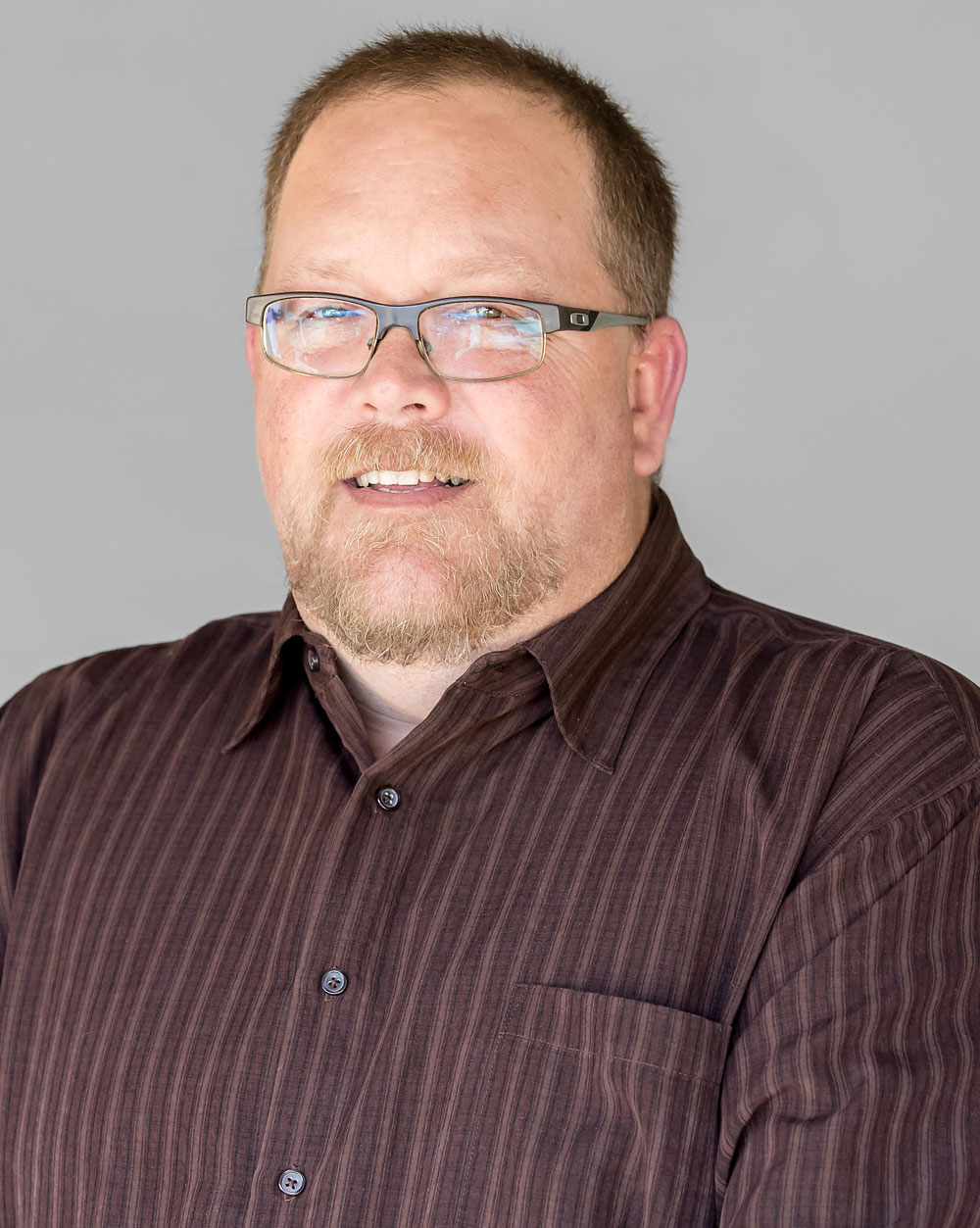 Robert Ferguson is a support engineer for Wheatstone. He has been in radio for more than 25 years, with experience both behind the board and in front of it as a broadcast engineer and on-air personality. He will be discussing the nuts and bolts of Social Distancing Your Studios during a webcast this Saturday, April 18.
Robert Ferguson is a support engineer for Wheatstone. He has been in radio for more than 25 years, with experience both behind the board and in front of it as a broadcast engineer and on-air personality. He will be discussing the nuts and bolts of Social Distancing Your Studios during a webcast this Saturday, April 18.
Blades. Essential Workers.
All the talk about essential workers gave us a renewed appreciation for the thousands of Blades out there at broadcast facilities (and a few at home), doing their job one bit at a time. Here’s one at iHeartMedia in Oklahoma that has been on the job seven years and running...
BLADE, KEEPS ON RUNNING
This I/O BLADE at iHeartMedia in Oklahoma had been running straight for 2,011 days at the time this photo was taken (Dec 2018). It’s attached to one of the first WheatNet-IP audio network systems that Clear Channel (now iHeartMedia) installed. It's still up and running continuously, making its last reboot almost seven years (2,536 days) ago when the group did a software update.
You can add mic processors to that list of essential workers we’ve been hearing about.
They take the brunt of whatever noise creeps into the microphone during a set, and lately, there’s been a lot of it. Mics are performing in less than ideal environments these days and subjected to all kinds of new sounds − kids yelling in the next room, a dog going off, the doorbell.
It’s nothing a good mic processor (like, our M1, M2 or M4IP) can’t handle, providing you’ve given it enough care and feeding.
Start with filtering. The right high-pass filter setting can do wonders for less than acoustically optimal environments. The idea is to roll up the frequency as far as one dares without impacting voice quality. Generally, that’s 50Hz on a male, 80Hz on a female announcer to remove noise without affecting the voice.
An expander or noise gate can effect a huge improvement by automatically reducing the gain − and so room noise and coloration − in speech pauses. Subtle is the word; just a few dB is all that's needed. Too much sounds clunky. The threshold should be set to open only on that announcer’s voice − not his neighbor’s, and certainly not the dog’s. (Open, fast <1mS; hang-time, say, 100mS; close, 100mS. Other manufacturers may use different nomenclature, like “attack,” “hold,” and “release.”)
If you’re getting too much low-frequency energy due to a clip-on lavalier mic picking up noise like the speaker’s chest resonance, you can use the processor’s parametric EQ controls to isolate the offending frequency and reduce it.
Lavalier mics can be overly “bright” in that they tend to produce a lot of high-frequency energy, typically at a peak boost between 3kHz and 8kHz, depending on the microphone. You can dial in a relatively broad EQ to smooth out the peak by starting with a parametric section set up for 5kHz, Q 0.5 (bandwidth 2 octave), and slowly attenuate.
If you’re still getting sibilance, there’s always the de-esser function. Simply adjust to ear, using 5kHz as the starting point. The beauty of a de-esser is that unlike ordinary EQ controls, it can take the bite out of sibilance without affecting the rest of the spectrum.
Finally, make sure that your essential worker has a very quiet mic preamp so it can handle whatever the microphone throws at it. We use super quiet preamps in our M4IP-USB mic processor − we actually call them Super-Quiet (SQ) microphone preamps! The M4IP-USB has four SQ preamplifiers that have an extremely low noise floor, very wide dynamic range, faithfully accurate transient response, and ruler flat frequency response. The M4IP-USB also uses high quality 24-bit A/D converters and a 96kHz base sample rate, so it doesn’t add undesired coloration to the signal and faithfully preserves the sound of any microphone and talent combination.
TV News Gets a Workout
Television stations adjusted to a new normal. WDRB-TV/WKBI-TV in Louisville started the year preparing for the Kentucky Derby, but the events of 2020 had other plans. Adding a pandemic and protests to the mix meant that its new Strata 32 console was juggling more feeds at once and bouncing from one newscaster to the next, many reporting in remotely.
The newsroom at WDRB TV 41 and WBKI TV 58 in Louisville, Kentucky, is getting quite a workout lately.
In a normal week, it produces over 58 hours of live and local news. Now with a pandemic added to the mix, the new Strata 32 TV audio board there is juggling a number of feeds at once and bouncing from one newscaster or reporter to the next – some reporting in remotely.
This is the first AoIP console for the Fox and CW/MyNetworkTV affiliates following years of service by a Wheatstone D8 TDM routed console.
“I didn’t make a conscious decision to go IP. It was more of a ‘this is the next generation, this is where everything’s headed,’” said WDRB Media Director of Production David Callan.
Now with the pandemic, he’s glad he made the transition to a fully IP audio networked board.
In addition to dedicated faders for eight subgroups and two masters along with 32 physical faders that can be layered for 64 channels, the Strata 32 has routable mix-minus with talkback interrupt, routable tracking, routable mic presets and most important to Callan, routable EQ, filtering, compressing/limiting and expander gate plus programmable delay – all of which he’s been able to integrate easily into the newsroom’s busy workflows.
“The sweet thing about this board is that I’ve actually been able to get my staff to embrace dynamics processing,” said Callan, explaining that it’s always been a challenge cutting from the “sports guys, who really like to project to the point of screaming, and then going to the weather announcer, who has more of a normal voice.”
Training staff on voice processing techniques had been done live on-air in the past, but now that the Strata32 provides true redundancy, Callan is able to train staff on the new console offline without every mistake going directly to air. Next up, he plans to establish floating presets specific to each sportscaster, newscaster and reporter that will give operators a starting point for processing mics on the fly.
WDRB TV 41/ WBKI TV 58 added the Strata 32 console to its news operation in September just as Callan began planning for the Kentucky Derby Festival’s Thunder over Louisville and the Kentucky Derby race, content of which he produces along with a staff of 200 every April and May at nearby Churchill Downs.
Covid-19 apparently had other plans and instead of holding the Kentucky Derby race as usual, Churchill Downs held a simulated Triple Crown race on May 2 to benefit Covid-19 emergency relief funds.
Throughout it all, the Strata 32 was in the newsroom as usual, taking it all in.
Streaming Gets a Shot in the Arm
Streaming rose to importance as drive-time listeners dwindled due to at-home workers. A report by TechSurvey 2020 came out in the summer indicating that almost two-thirds of stream consumers listen to their local radio station’s stream, ahead of Pandora, YouTube and Spotify. As a result, our StreamBlade joined the rock star club as the first AoIP appliance and audio processor designed specifically for increasing the quality of streamed audio content.
Things are definitely looking up for broadcasters in the streaming department. According to TechSurvey 2020, almost two-thirds of stream consumers listen to their local radio station’s stream, ahead of Pandora, YouTube and Spotify.
We know that creating an online signature sound is just as important as over the air radio.
We also know you can’t paint streaming with the same audio processing brush, especially when it comes to controlling levels and spectral balance. Here is why.
The blurry picture on the left represents what happens if you used aggressive compression on encoded audio similar to that used in FM processing. Extreme time constants create distortion in the audio that not only mask subtle detail, but cause the encoder to allocate bits to that distortion instead of to the desired program content. Compared to the picture on the right, less detail makes the audio sound “blurry.” Added distortion is bad for any stream, but it’s especially bad for low bitrate streams that end up with less of the original audio as it is.
The typical broadcast approach to inconsistent levels is to apply multiband gain control followed by fast compression or limiting to build uniform loudness and density. Instead, StreamBlade uses neural network techniques to map processing time constants to precisely what is required to provide consistent loudness and density from one program element to the next, and without adding distortion.
StreamBlade then uses a two-band final limiter to handle peak overshoots and limit them below 0dBFS (the point at which digital runs out of bits). Designed specifically for streaming and to optimize the performance of codecs, the limiter gets the job done without “pumping” or other artifacts that can further degrade the quality of audio passing through the codec.
You can find out more by viewing Processing For Streaming, presented by Wheatstone Senior Development Engineer Rick Bidlack.
By Scott Gerenser and Andy Calvanese
One term popping up more and more in the cloud space is "containerization." If you're paying attention to the trends in cloud computing, you've probably heard about it, or at least about the most popular container platform, Docker.
Containerization is becoming a popular alternative to virtualization for running many different applications on a single machine or cloud instance. It has many of the benefits of virtualization but without some of the downsides, which makes it useful for transitioning from a fixed-location studio to a virtual operation.
Whereas virtualization involves emulating an entire machine, including the hardware and operating system, containerization involves encapsulating one or more applications and supporting files (so called "userspace" in Linux lingo) into containers that can then run on top of a single common operating system (usually Linux).
For example, in a virtualization scenario, you might have a server running VMWare ESXi hypervisor software, upon which are four Unbuntu Linux virtual machines for Service X, two Red Hat Linux VMs for Service Y, and a couple of Windows 10 Server VMs to handle any Windows applications you have.
Using virtualization this way still provides big benefits over maintaining multiple physical machines. Administration is easier. Spinning up a new server or changing configurations of the individual VMs is much easier than tinkering with hardware. Communication between the VMs is very fast and efficient. The downside, as compared to containerization, is the relatively large overhead associated with virtualization. This is because each VM is running a complete OS kernel, each with their own dedicated memory and each using up a percentage of your CPU to mostly do a lot of the same things.
Containerization, by comparison, also allows the running of a number of different isolated services on one machine, but within containers rather than full virtual machines. Conceptually, a container can be thought of as a very lightweight, resource efficient VM. One container could host WheatNet-IP audio processing tools, while another could host the station automation system, each totally isolated yet run off the same OS kernel. Because each container operates independently of the others, you can avoid unintended interactions between software components and eliminate a single point of failure. Each application or container communicates with the others only through their defined APIs. The container virtualization layer is extremely flexible and can scale up to meet rising demand for any of the services. Once you define what services are running in one or more containers, it’s possible to move those containerized services between on-premise machines and the public cloud. This allows you to more easily scale services locally at your regional studio or in a cloud provider such as AWS or Azure.
And unlike with virtualization, there is no extra supervisory overhead to contend for resources, and containerization platforms are even able to run on top of virtualization platforms. This last point is critical for long term planning, since Amazon, Microsoft and other public cloud providers are already running hypervisor software on their cloud instances. Attempting to add your own VM hypervisor on top of a cloud provider's machine instance may work poorly, or not at all. Containers, by contrast, work well on just about all the cloud providers and instance types. Most providers even offer tools to make it easy to manage and coordinate your containers running in their cloud.
Fundamentally, containerization and virtualization are two different ways of doing the same thing. Having several containers running separate services pushed up to a cloud won’t solve issues such as communication latency over the internet, but it will offer some added security protection, flexibility, and let you allocate resource more efficiently, which is the point of the cloud after all.
Scott Gerenser is a Senior Software Engineer at Wheatstone Corporation. View Gerenser’s presentation Studio Elasticity, from Hardware to Virtual to Cloud.
New Nielsen Development
Our audio engineers also continued to work with Nielsen developers in advance of the Nielsen Audio Software Encoding release for FM stations planned for early 2021. By year end, we were ready for all the final field testing (required to receive the Nielsen certification for our X5 FM/HD audio processor) that wil take place later this spring.
GSX. The Console That 2020 Built.
Prior to 2020, we began development on a companion console to our LXE that could be fully reprogrammable. Once the events of 2020 began to unfold, the GSX took on a life of its own as the first fully reprogrammable console to come out of 2020 that addresses the workflows deeply affected by the events of the past year.

Here is the console that 2020 built. The GSX console surface is the first fully reprogrammable console to come out of 2020 that addresses the broadcast workflows deeply affected by the events of the past year.
Based on our LXE console surface, the 24-channel GSX has reprogrammable soft buttons and touchscreen control. It has tap-through menuing, onboard OLED displays, and optional Remote GSX client software that can be set up at home or elsewhere to mirror and remotely control the GSX physical console at the station studio.
GSX integrates with existing WheatNet-IP audio networks and the new Blade 4, our fourth generation WheatNet-IP I/O unit and another new product to come out of 2020 that includes new AoIP tools such as integrated encoding, interoperability and redundancy.
Check out the video below – Jay Tyler talks to Paul McLane about the new GSX.
By Rick Bidlack
I suppose that for all of us there are inflexion points in our lives where you meet someone or experience some new thing that changes your life thereafter. Charlie Brown was such a turning point for me. He was also my introduction to radio. At the time we met, Charlie had been retired from a successful thirty-three year career in broadcasting where he had worked at Seattle’s top stations as a morning man, holding court and ruling the airwaves in a Top 40 format. His love of radio and wanting to bring the best content to his listeners drove him to create VoxPro in 1992, bringing it to market in 1994 (as a Mac application). Replacing reel-to-reel machines with computer software was a hard sell, but his own and other early adapters’ use of the product made it a reality.
Charlie and I were brought together through two degrees of mutual friends – he was looking for a programmer to complete the rollout of VoxPro to the Windows® platform, and I was freshly unemployed from my third dot-com implosion in a year. It was the summer of 2001. The venue, Audion “Laboratories,” was a 12’ x 20’ cabin on the back of Charlie and Kimberly’s property, and there was a 40-minute ferry ride involved in getting there. I thought, “how amazing, perhaps even impudent, to think that you can develop a new product with a skeleton crew and no budget and bring it to market,” but after having been burned by the venture capitalists enough times I was willing to take a chance. So Charlie led me through that process, and he introduced me to the radio family. He wasn’t technical, but he had excellent instincts about technology. He was unfailingly kind, generous, optimistic, and infinitely forgiving of my many shortcomings and missteps. We had a wonderful journey together at Audion (“Audion-and-on-and-on…”) for 14 years, during which time I got to see his idea, VoxPro, become the pre-eminent editor in radio. He was a model of the well-lived life, an example of what persistent hard work and the willingness to take a risk can bring. I will miss him greatly.
Rick Bidlack joined Wheatstone in 2015 along with VoxPro. He continues Charlie Brown’s legacy as Wheatstone’s lead developer on VoxPro.
The Wheatstone online store is now open! You can purchase demo units, spare cards, subassemblies, modules and other discontinued or out-of-production components for Wheatstone, Audioarts, PR&E and VoxPro products online, or call Wheatstone customer support at 252-638-7000 or contact the Wheatstone technical support team online as usual.
The store is another convenience at wheatstone.com, where you can access product manuals, white papers and tutorials as well as technical and discussion forums such as its AoIP Scripters Forum.
Compare All of Wheatstone's Remote Solutions
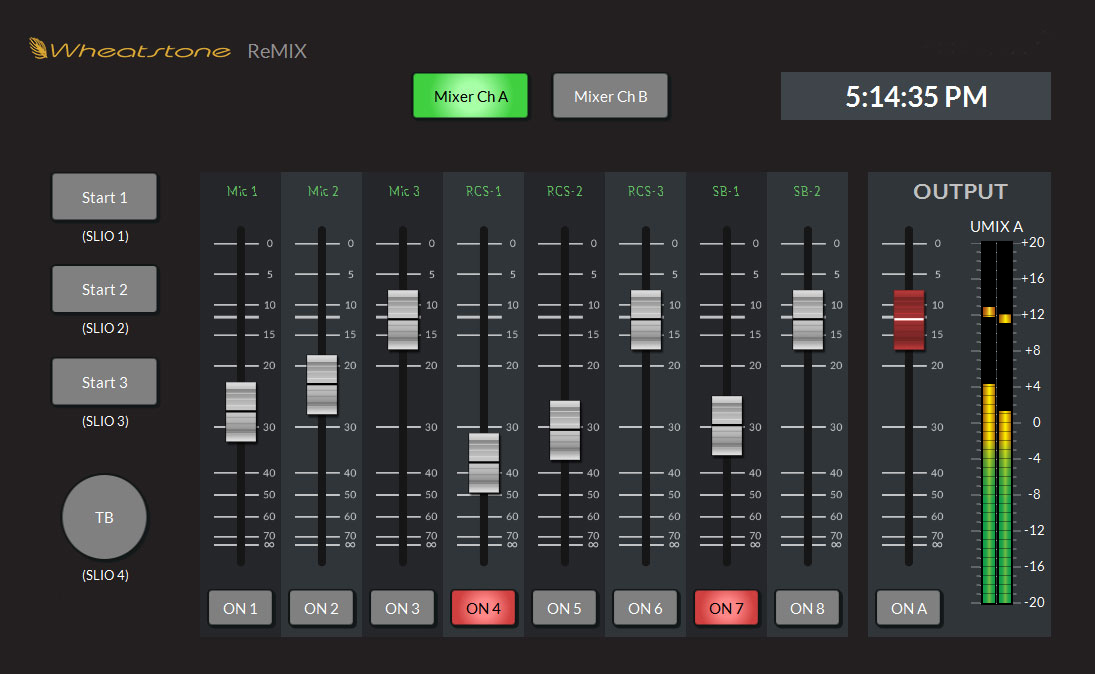 We've got remote solutions for virtually every networkable console we've built in the last 20 years or so. For basic volume, on/off, bus assign, logic, it's as easy as running an app either locally with a good VPN, or back at the studio, using a remote-access app such as Teambuilder to run.
We've got remote solutions for virtually every networkable console we've built in the last 20 years or so. For basic volume, on/off, bus assign, logic, it's as easy as running an app either locally with a good VPN, or back at the studio, using a remote-access app such as Teambuilder to run.
Check out the chart below, and/or click here to learn more on our Remote Solutions web page.
Remote Solutions Video Demonstrations
Jay Tyler recently completed a series of videos demonstrating the various solutions Wheatstone offers for remote broadcasting.
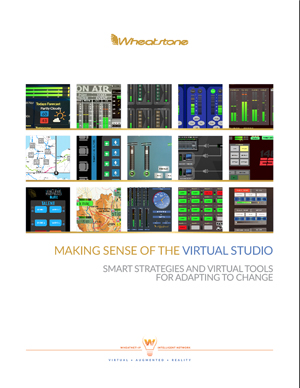 Making Sense of the Virtual Studio
Making Sense of the Virtual Studio
SMART STRATEGIES AND VIRTUAL TOOLS FOR ADAPTING TO CHANGE
Curious about how the modern studio has evolved in an IP world? Virtualization of the studio is WAY more than tossing a control surface on a touch screen. With today's tools, you can virtualize control over almost ANYTHING you want to do with your audio network. This free e-book illustrates what real-world engineers and radio studios are doing. Pretty amazing stuff.
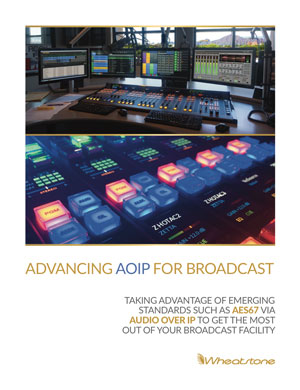 Advancing AOIP for Broadcast
Advancing AOIP for Broadcast
TAKING ADVANTAGE OF EMERGING STANDARDS SUCH AS AES67 VIA AUDIO OVER IP TO GET THE MOST OUT OF YOUR BROADCAST FACILITY
Putting together a new studio? Updating an existing studio? We've put together this e-book with fresh info and some of the articles that we've authored for our website, white papers, and news that dives into some of the cool stuff you can do with a modern AoIP network like Wheatstone's WheatNet-IP.
Got feedback or questions? Click my name below to send us an e-mail. You can also use the links at the top or bottom of the page to follow us on popular social networking sites and the tabs will take you to our most often visited pages.


